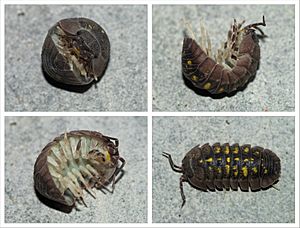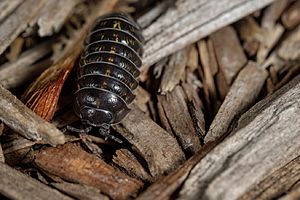Armadillidiidae facts for kids
Quick facts for kids ArmadillidiidaeTemporal range: Chattian-recent
|
|
|---|---|
 |
|
| An Armadillidium granulatum in various stages of conglobulation, i.e., "rolling up" | |
| Scientific classification |
|
| Kingdom: | Animalia |
| Phylum: | Arthropoda |
| Subphylum: | Crustacea |
| Class: | Malacostraca |
| Superorder: | Peracarida |
| Order: | Isopoda |
| Suborder: | Oniscidea |
| Section: | Crinocheta |
| Family: | Armadillidiidae Brandt, 1833 |
| Genera | |
|
See text |
|
Armadillidiidae is a family of small creatures called woodlice. They are a type of crustacean that lives on land. You might know them better as pill bugs or roly polies.
What makes these woodlice special is their amazing ability to roll up into a tight ball. They share this trick with other animals like pill millipedes. This cool defense mechanism gives them their common names. You might also hear them called slaters or potato bugs in some places. Most species come from the Mediterranean area. However, one well-known species, Armadillidium vulgare, is now found all over North America.
Common Names for Pill Bugs
Pill bugs have many different names around the world! Here are some of the most common ones:
- Pill bug (Global)
- Rollie Pollie, Roly Poly (USA)
- Woodlice (UK, Australia)
- Slater Bugs (Australia)
- Cheesy bug (parts of UK)
- Sowbug (USA)
- Doodlebug (Southern USA)
- Slater (Australia, New Zealand, Scotland, Ireland)
- Butcher boy (Australia)
- Cellar Bugs (Germany)
- Carpenter (certain USA regions)
- Door closer (Francophone regions)
- Parsons Pig (UK)
- Bench biters (Denmark)
- Chiggy pig (Devon, UK)
- Chuckie pig (Southern USA)
- Gramersow (Cornwall, UK)
How Pill Bugs Live and Behave
Pill bugs in the Armadillidiidae family can roll their bodies into a perfect ball. This action is called conglobation. It's a great way to protect themselves from danger. They might roll up if they feel vibrations or pressure. This behavior also helps them save water.
Their bodies are made of many segments, like armor plates. These plates, called tergites, overlap and have flexible joints. This design lets them roll up tightly. Special muscles help them pull their body segments inward.
Pill bugs mainly eat dead or decaying plants. This includes leaves and wood fibers. They can also eat living plants, especially when it's wet. Sometimes they munch on leaves, stems, roots, and fruits.
In some farms, pill bugs can become a problem. They are attracted to old plant matter left in fields. This can lead them to eat new, young plants. Farmers in places like Southern Australia have seen this happen. They can damage crops like corn, beans, and strawberries. Pill bugs can also eat decaying animal parts or even shed snakeskin.
Pill bugs are important helpers in nature. They are decomposers, which means they break down dead plants. This helps return nutrients to the soil.
Pill Bug Classification
Scientists tell the Armadillidiidae family apart from other woodlice in a few ways. They look at the pill bug's antennae, which have two parts. They also check the shape of their uropods, which are small parts at the end of their body. And, of course, their ability to roll into a ball is a key feature!
Within the Armadillidiidae family, there are many different types, called genera. For example, the most common type you might see is from the genus Armadillidium. Scientists are always studying these creatures. They sometimes discover new species and even new genera!
See also
 In Spanish: Armadilídidos para niños
In Spanish: Armadilídidos para niños


